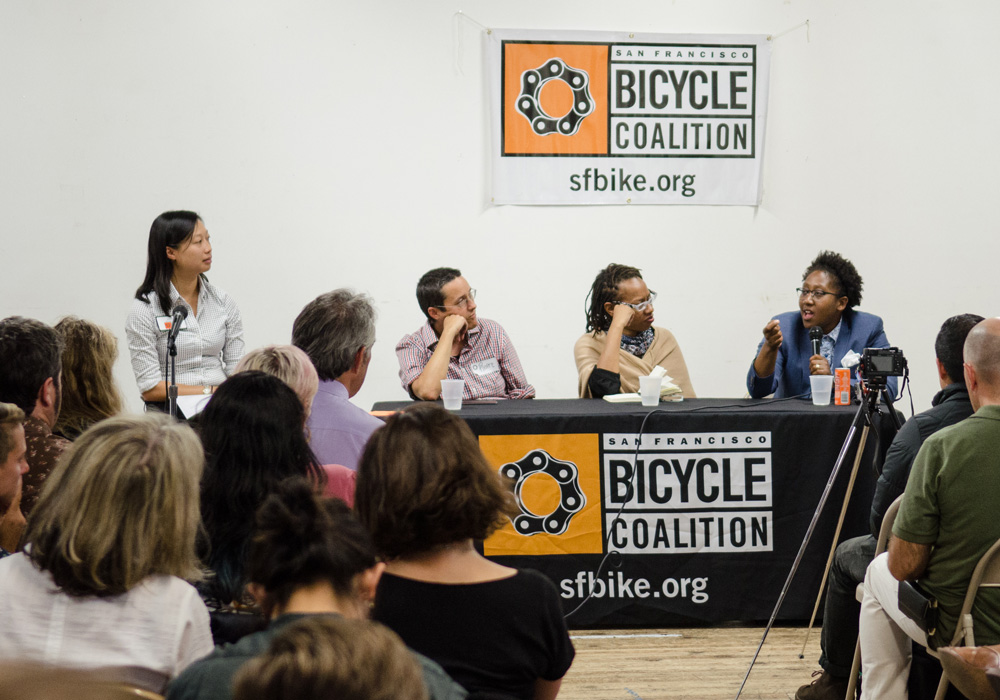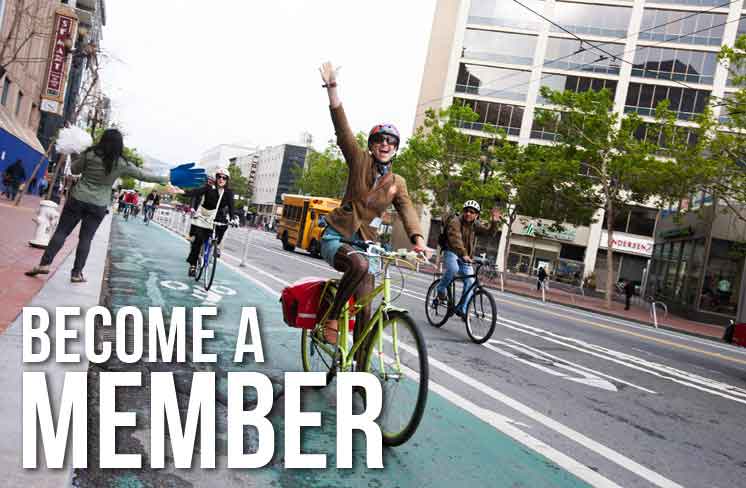Editors: This story was originally published in Issue 159 of our quarterly Tube Times magazine, one of many perks of membership in the San Francisco Bicycle Coalition.
On Nov. 9, 2016, we woke up to a reality unfamiliar to some, while already painfully obvious to others: We live in a divided, fractured country with the frayed binds that tie us together under attack.
In the few months since, many of us have begun some version of soul-searching and trying to move forward. Many of us are refocusing locally and wrapping our heads around a simple concept: What does it mean to build community? What does it look like? And how do we make it happen?
I want to burden all of us with one more crucial, weighty question: Who is building your community, and for whom are they building it?
At the SF Bicycle Coalition, we strive to prioritize people in our work, our goals and our language. Our work isn’t about commutes, it’s about communities. It’s not bikes that bring us together; it’s people who bike. We advocate and raise our voices when needed because we believe that there can and should be more people enjoying our city by bike.
Last September, I was fortunate to host an incredible panel, including Lateefah Simon (since elected to the BART Board with our endorsement), Renee Rivera (executive director of Bike East Bay) and Tamika Butler (executive director of LA County Bicycle Coalition). Over the course of two hours, we talked about what it means to grow our movement, and at one point, Tamika quoted Audre Lorde: “There is no such thing as a single-issue struggle because we do not live single-issue lives.”
As a queer woman and an immigrant that lives somewhere in the hyphenated space between “Asian” and “American,” I am a messy set of identities before I get on my bike. That shapes how I ride in the city, where I go and why I’m biking in the first place. If life is some version of learning how to navigate the self, then my bike is how I navigate my life in San Francisco. As I heard Audre’s words offered by Tamika, I was reminded that we need to not only see our city from the saddle.
Therefore, my 2017 resolution is to embrace intersectionality and challenge myself to do my work at the SF Bicycle Coalition through this lens in every moment. Intersectionality is not just a theory, but a concept that needs to be lived, informing the how and the why of every action.
What does it mean to be “intersectional”? First introduced by civil rights advocate Kimberlé Crenshaw in a 1989 essay, this term has come to mean the space where overlapping social identities and oppressions converge. The idea acknowledges the fact that we do not live single-issue lives because our identities are at the intersection of all the things we are, all the things we do, and all the privilege that we do or don’t hold.
How does this apply to the world of bicycle advocacy? With the power of our 10,000-plus members, the bread and butter of our work has been street campaigns – to fight for (and win) better bike infrastructure and transform our streets into more bike-friendly places. Our work has made San Francisco a better place to live, a healthier place for families to grow and a more beautiful city to get around, and the starting point has most often been from the saddle.
There is something elegant in the bicycle as a symbol of intersectionality in San Francisco. We feel it acutely on our streets, as we try to establish ourselves between fast-moving traffic, parked cars, Muni vehicles, curbs and crosswalks. Often, we need to fight for that space to exist: We mobilize at City Hall, stuff an elected official’s inbox or make noise out on the streets.
While biking in San Francisco has advanced, the city has changed. It seems that San Francisco ranks on a new list of “most expensive cities” every week, while more and more people are displaced by gentrification. Diversity in San Francisco is plummeting; the latest 2010 Census showed that our black population has dwindled to less than six percent, down from over 13 percent in the 1970s. The affordability crisis has pushed out families, too; children only make up 13 percent of our population, which is the lowest percentage of children in any of the largest 100 cities in the country.
Viewing biking in San Francisco intersectionally means we cannot look at the bicycle without the context of what’s happening in our city, and that bike improvements are not neutral in how they affect people’s lives. It means accepting a new starting point and different perspectives of our work. It means examining how our identities – race, gender, age, income, occupation, et al. – do and don’t intersect with biking.
We have to remember that the bicycle isn’t always front and center, and to be good partners in making a great city, we have to recognize that we face different experiences before we even get on a bike. Join me in 2017 to build community and intersectionality with the bicycle.
Intersectionality in Action
When we think of civic engagement, we think of City approval processes: engineering hearings, board and commission approvals, environmental reviews, and so forth. Here are a few ways to take civic engagement a step further and build community.
Join Your Local Neighborhood Association
From microhood to microhood, every inch of San Francisco is covered by at least one neighborhood association. Look up your local group and meet your neighbors to find out what’s happening where you live. This is your opportunity to learn what your community cares about. Chances are, it’s not biking.
Explore Local Political Clubs
What better way to elect officals you belive in and pass ballot measures you want than to endorse them directly? San Francisco has political clubs for every persuasion, and there are a variety of issues that clubs take on when it comes to endorsements. Gear up for 2018 by connecting with your local political clubs.
Attend a City-led Task Force
From immigration rights to financial justice, the City has a variety of active task forces focusing on particular issues to move local policies and laws forward. Many of the city’s biggest advocates serve on these task forces, and it’s a great way to dive right into the tough issues San Francisco faces. Task force meetings are generally open to the public and provide a space for participants to listen in.
Say Hello in the Bike Lane
If you’re an everyday bike commuter, take time to say hello to those biking around you. We ride with countless people on a regular basis. Next time you’re waiting at a red light, say hi to your fellow bike riders. For this brief minute, you share a space on the street together, and that little space just might be where we find fleeting moments of community.
The Tube Times is published quarterly as one of the many benefits to members of the SF Bicycle Coalition. For a complete list of membership benefits, or to join/renew today, click here.


